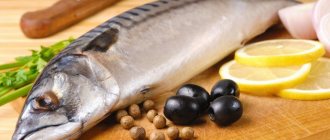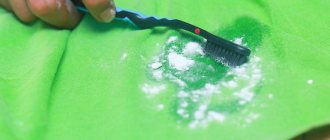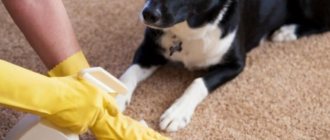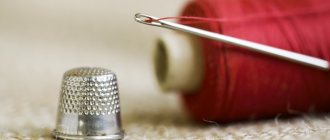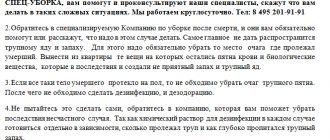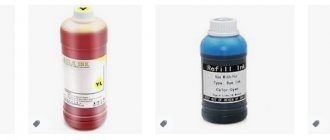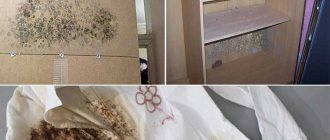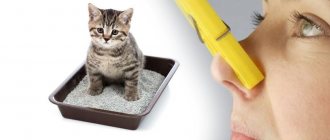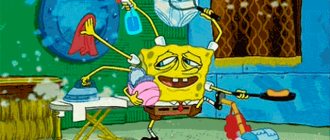How can you remove silicate glue from clothes without ruining the fabric? Probably, this question has arisen for everyone, because silicate glue is often used in everyday life, and sooner or later everyone faces the problem of removing glue stains from things. Fortunately, it is not very difficult to remove silicates from fabric; you can return your favorite item to its original appearance without resorting to dry cleaning.
You can remove glue stains at home
PVA
Fresh PVA stains can be removed from any material.
- If the glue has not yet penetrated into the structure of the fabric, carefully remove it from the surface of the clothing with a terry cloth or napkin.
- Place the stained area under running warm water from the reverse side.
- Lather the area with laundry soap and leave for 5-10 minutes.
- Wash and rinse.
When removing dried PVA stains, you should take into account the characteristics of the fabric.
- To get rid of a stain on cotton or denim, first dissolve it. Soak a cotton pad in vinegar and wipe the stained area with it. The glue will come off like a film. Then wash the clothes in warm water.
- If the glue has become embedded in the suede, hold the fabric over steam for 10 minutes. Then remove it with a cotton pad soaked in ammonia.
- To remove stains from delicate fabric, place the item in the freezer for an hour and a half. The glue will become brittle and it will be enough to clean the item by hand.
Do not use solvents or alcohol solutions on delicate fabrics. This may result in material damage.
Extreme surface cleaning methods
If the stain is old and it was not possible to get rid of it using any of the above methods, you need to pay attention to extreme methods. It is worth noting that you need to resort to them only in extreme cases, since during the implementation process there is a high probability that the glass will crack:
- Setting fire to alcohol. A small amount of alcohol is applied locally to the area of contamination and set on fire. After the fire goes out on its own, the softened adhesive mass can be removed using a stationery knife or blade. Finally, the residues are removed with a soft rag or sponge soaked in clean water.
- Heating with an iron or hairdryer. Traces of glue from a car sticker are usually removed in this way: a stream of hot air is directed to the stained areas. As it burns, the glue is easily removed.
Another fairly common problem is how to wash your hands off adhesive from a windshield or any other glass surface. To remove dirt from the skin, use sunflower oil, rich cream or white spirit solution, liquid soap or nail polish remover.
When removing stains from glass, it is important to follow personal safety rules, since almost all compositions are quite aggressive. To avoid the development of an allergic reaction or chemical burns, you need to work with rubber gloves and a respirator.
"Titanium"
“Titanium” firmly binds various materials, so it is difficult to remove from clothing.
- Place the product on a horizontal hard surface and cover with another cloth on top. Gently tap with a hammer or other hard object and use your hands to separate the adhesive from the material. Wash the item in hot water and laundry soap.
- Natural fabric can be cleaned with acetone or dimexide. Apply a cotton swab soaked in the product to the stain for half an hour, then scrub with a stiff brush.
What does the type of adhesive affect?
Before you begin cleaning the glass, it is advisable to determine what kind of glue was used to create the stains. Some types can be easily removed even with ordinary water, especially while they are not dry; for others, you will need to make an effort and use special tools.
| Cleaning agent | Glue type | Note |
| Water | Water based glue. This type includes stationery, PVA, latex, carpentry | This cleaning agent can only be used while the glue is still wet. |
| Hot water + eraser | Adhesive from masking tape | The method is suitable even for dried traces |
| Liquid soap | From masking tape, from PVA, from stickers | The product is effective for fresh stains |
| Fat (vaseline, vegetable oil) | Sticker marks, tape | Afterwards treatment with anti-grease is required |
| Ammonia | Stickers, tape, carpentry tape, PVA, tinting glue | |
| Wiper | Any | |
| Ice | stickers, tape | Care is required to avoid sudden temperature changes. |
| Alcohol | Any | |
| Vinegar | tape, labels | |
| Petrol | silicone, etc. | |
| Steam | stickers, tape, etc. | Avoid sudden temperature changes |
| Acetone | super glue, silicone, etc. |
Any type of glue is best removed while it is fresh and has not set to the surface.
Silicone
Silicone sealant hardens at room temperature. If it gets on the fabric, immediately stretch the fabric so that the glue hardens in the form of a film that can be easily removed by hand.
For dried stains you can use vinegar:
- Soak a cotton swab in vinegar and blot the stain.
- Leave for 30-35 minutes.
- Then wash with laundry soap.
For old and large stains on natural fabrics, use acetone:
- Blot the stain with a cotton pad soaked in acetone. If the area of contamination is very large, you can use a piece of white cloth instead of cotton wool.
- Leave for 30–40 minutes.
- When the glue clumps together, scoop them up with a soft brush or sponge.
- Wash as usual.
Recommendations
you remove glue from glass :
- If home methods are ineffective, you can resort to special means.
- When cleaning the glue with a knife or blade, you can damage the glass and leave scratches on it.
- It is recommended to use cleaning chemicals in a well-ventilated area using rubber gloves.
- In the process of cleaning the glass, when the glue begins to soften, it is better to remove it immediately so that it does not spread over an even larger area.
- When removing glue, you must try not to get solvents on rubber, plastic and metal parts.
How to remove glue from shoes
It is necessary to remove glue from shoes taking into account the surface material.
Suede
If the glue has not yet dried, it can be removed using a metal nail file. The adhesive must be carefully collected in a circular motion.
You can remove old stains using ammonia (5%) or nail polish remover (without acetone). You need to moisten the contaminated area with one of these products and remove the softened mass with a cotton swab.
Shoes made of fabric can be cleaned using any alcohol-containing product: apply to the stain for 15 minutes and remove the glue.
Leather and leatherette
- Moisten the glue with acetone.
- Leave for an hour.
- Wipe with a soft brush.
- Repeat as necessary.
- Apply shoe paint.
Traditional methods
When you don’t want to subject products to chemical and heat treatment, it is recommended to prepare natural recipes from ordinary ingredients. Of course, they will act a little slower on dried glue, but it is worth considering that home remedies are safe, do not affect the human body and have a gentle effect on the material.
- Alcohol. We saturate a rag with the component, hold the top of the stained area, after 10 minutes we clean it with a plastic object and rinse thoroughly.
- Soda and salt. They are sold in powder form and contain abrasive elements that have a mechanical effect on the glue. So, pour salt or soda with water to form a thick paste, then apply to the problem area, rub lightly and after 15 minutes remove with a scraper.
- Oil. The product must contain a high percentage of fat content. Using a rag swab, apply oil to the surface several times, wait 40-50 minutes, then take a soft rag and clean the area that has been softened by glue. If you don’t have oil, you can use Vaseline or fatty cream for manipulation.
- Lemon juice/citric acid. Squeeze a little lemon juice onto a horizontal surface, wait half an hour, then gently scrub the problem area with a toothbrush. If there is no citrus, then dilute citric acid in water.
- Vinegar. The product contains special acids that react with the glue, softening it. We apply the product to the area, wait until the glue becomes plastic, then we carry out the treatment and clean the surface.
How to remove label marks from clothes
If the manufacturer has not taken care of the quality of the labels, then traces of them on clothes are difficult to remove. If you cannot roll up the remaining sticker with your fingers, you can try three proven methods:
- Use masking tape. Stick it on the footprint and pull it off with a sharp movement.
- Warm up the label mark with a hairdryer, then apply vegetable oil to the area. And immediately remove it along with the adhesive substance with a rag.
- Apply vegetable oil to the fabric and leave for 5-10 minutes. The glue can be easily removed using a plastic card or a piece of cloth of the same material.
Oil methods are only suitable for natural fabrics. Oil stains are difficult to remove from synthetic materials.
There are a lot of means that you can use to get rid of the sticky stain and save your clothes. The result will be positive if you follow the instructions. You can also take the item to a dry cleaner, where professionals will clean the item.
Comments 46
reply to comment by Lech 1984
Hello. Tell me in what proportion should rubber glue grade A (in 50 ml tubes “NOVBYTHIM”) be diluted with “Galosha” gasoline (nefras-s2) to obtain the optimal composition of the glue. Is the stickiness lost when diluted?
reply to comment by Lech 1984
Hello. Tell me in what proportion should rubber glue grade A (in 50 ml tubes “NOVBYTHIM”) be diluted with “Galosha” gasoline (nefras-s2) to obtain the optimal composition of the glue. Is the stickiness lost when diluted?
reply to comment by Lech 1984
Hello. Tell me in what proportion should rubber glue grade A (in 50 ml tubes “NOVBYTHIM”) be diluted with “Galosha” gasoline (nefras-s2) to obtain the optimal composition of the glue. Is the stickiness lost when diluted?
reply to comment by Lech 1984
Hello. Tell me in what proportion should rubber glue grade A (in 50 ml tubes “NOVBYTHIM”) be diluted with “Galosha” gasoline (nefras-s2) to obtain the optimal composition of the glue. Is the stickiness lost when diluted?
reply to comment by Lech 1984
Hello. Tell me in what proportion should rubber glue grade A (in 50 ml tubes “NOVBYTHIM”) be diluted with “Galosha” gasoline (nefras-s2) to obtain the optimal composition of the glue. Is the stickiness lost when diluted? __________________________
Reply to ViktorL's
It's useless! Nothing will definitely stick to my base.
